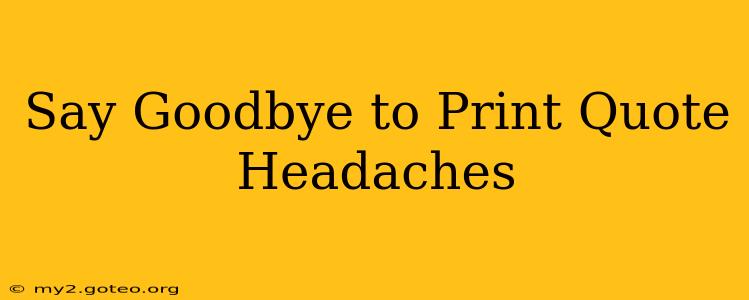Getting accurate print quotes can feel like navigating a minefield. Inconsistent pricing, hidden fees, and confusing jargon often lead to frustrating delays and unexpected costs. But it doesn't have to be this way. This comprehensive guide will help you streamline your printing process and finally say goodbye to those print quote headaches.
What Makes Getting Print Quotes So Difficult?
Many factors contribute to the difficulties surrounding print quotes. Let's break down some of the most common challenges:
- Lack of Clear Specifications: Ambiguous descriptions of your print job (size, paper type, quantity, finishing options) lead to inaccurate estimates. Providing detailed specifications upfront is crucial.
- Hidden Fees: Unexpected charges for things like design revisions, rush fees, or shipping can significantly inflate the final cost. Transparency is key when selecting a printer.
- Inconsistent Pricing: Different printers use varying pricing structures, making it difficult to compare apples to apples. Requesting quotes from multiple vendors is essential for fair price comparison.
- Jargon and Technical Terms: Navigating industry terminology can be confusing, especially for those unfamiliar with the printing process. Ask clarifying questions if anything is unclear.
- Difficulty in Comparing Quotes: When quotes are presented in different formats or lack key details, comparing them becomes a time-consuming and error-prone task. Standard formats and clear breakdowns help immensely.
How to Get Accurate and Reliable Print Quotes
Here's a step-by-step approach to help you obtain clear, accurate, and reliable print quotes, minimizing the likelihood of unforeseen problems:
1. Define Your Project Clearly
Before contacting any printers, meticulously detail your project requirements. Consider these aspects:
- Project Type: Flyers, brochures, business cards, posters, etc.
- Dimensions & Quantity: Precise measurements and the total number of prints needed.
- Paper Type & Weight: Specify the exact paper stock (e.g., coated, uncoated, cardstock) and its weight (e.g., 80lb, 100lb).
- Color Process: Full color, black and white, or spot color.
- Finishing Options: Binding (if applicable), lamination, cutting, folding, perforations.
- Design Files: Ensure your design files are in the correct format (e.g., PDF, AI) and ready for printing.
2. Choose the Right Printer
Select printers based on their reputation, experience, and specialization. Consider factors like:
- Reviews & Testimonials: Check online reviews and testimonials to gauge their customer service and quality of work.
- Specializations: Some printers specialize in specific print types (e.g., large-format printing, high-end brochures).
- Location & Turnaround Time: Consider proximity for quicker delivery or the printer's turnaround time if you have a tight deadline.
3. Request Quotes from Multiple Printers
Never rely on a single quote. Contact at least three different printers, providing them with the same detailed project specifications. This allows for fair comparison and price negotiation.
4. Carefully Review Each Quote
Examine each quote meticulously, ensuring it includes:
- Itemized Breakdown: All costs should be clearly itemized, leaving no room for hidden fees.
- Total Cost: The final cost, including taxes and shipping, should be clearly stated.
- Production Timeline: Understand the expected turnaround time for the entire process.
- Payment Terms: Clarify the payment methods and deadlines.
5. Ask Clarifying Questions
Don't hesitate to contact the printer directly if anything is unclear. Asking clarifying questions demonstrates your attentiveness and ensures you fully understand the quote.
What are the most common hidden costs associated with printing?
Common hidden costs include rush fees (for expedited printing), design revisions beyond a certain number, shipping and handling fees, and additional charges for special finishing techniques not initially specified in the quote. Always ask for a completely itemized cost breakdown to avoid surprises.
How can I compare print quotes effectively?
For effective comparison, create a table listing each printer, their total cost, turnaround time, payment terms, and a summary of any included or excluded services. This systematic approach makes it much easier to assess which quote offers the best value for your needs.
What file formats should I provide to my printer?
High-resolution PDF files (in CMYK color space) are generally preferred by printers. Other acceptable formats may include AI, EPS, or TIFF files, but it's always best to check with the printer about their specific file requirements to avoid any issues.
How can I avoid print quote surprises?
The key to avoiding surprises is clear communication and thorough preparation. Provide the printer with meticulous details of your project, request a completely itemized quote, and don’t hesitate to ask clarifying questions about anything you don’t understand. By doing this, you take control of the process and minimize the likelihood of unexpected costs.
By following these steps, you can navigate the world of print quotes with confidence, securing the best possible price and avoiding unnecessary headaches. Remember, preparation and clear communication are your greatest allies in this process.

